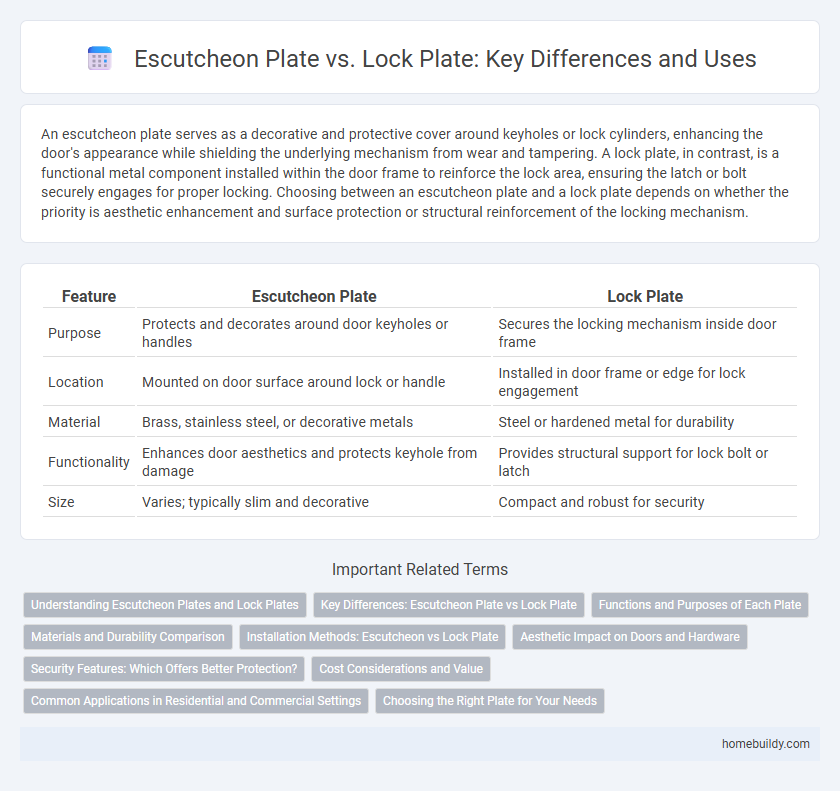An escutcheon plate serves as a decorative and protective cover around keyholes or lock cylinders, enhancing the door's appearance while shielding the underlying mechanism from wear and tampering. A lock plate, in contrast, is a functional metal component installed within the door frame to reinforce the lock area, ensuring the latch or bolt securely engages for proper locking. Choosing between an escutcheon plate and a lock plate depends on whether the priority is aesthetic enhancement and surface protection or structural reinforcement of the locking mechanism.
Table of Comparison
| Feature | Escutcheon Plate | Lock Plate |
|---|---|---|
| Purpose | Protects and decorates around door keyholes or handles | Secures the locking mechanism inside door frame |
| Location | Mounted on door surface around lock or handle | Installed in door frame or edge for lock engagement |
| Material | Brass, stainless steel, or decorative metals | Steel or hardened metal for durability |
| Functionality | Enhances door aesthetics and protects keyhole from damage | Provides structural support for lock bolt or latch |
| Size | Varies; typically slim and decorative | Compact and robust for security |
Understanding Escutcheon Plates and Lock Plates
Escutcheon plates serve as decorative and protective coverings around door handles or keyholes, enhancing both aesthetics and durability by preventing wear on surrounding surfaces. Lock plates, on the other hand, are integral to the locking mechanism, reinforcing the door frame and ensuring secure engagement of the lock bolt or latch. Distinguishing between these components is essential for selecting appropriate hardware that balances security, functionality, and design.
Key Differences: Escutcheon Plate vs Lock Plate
An escutcheon plate primarily serves as a protective and decorative cover around keyholes or lock cylinders, enhancing the aesthetic appeal while preventing wear on the door surface. In contrast, a lock plate is a structural component integrated into the door frame or edge, designed to reinforce the locking mechanism and secure the latch or deadbolt. The key differences lie in function and placement: escutcheon plates focus on exterior appearance and protection, whereas lock plates provide mounting strength and security for the locking system.
Functions and Purposes of Each Plate
Escutcheon plates primarily serve as decorative protection around keyholes or door handles, enhancing aesthetic appeal while preventing wear and damage to the door surface. Lock plates focus on reinforcing the door frame or lock mechanism, improving security by providing structural support against forced entry. Both plates complement each other by combining ornamental design with functional security in door hardware.
Materials and Durability Comparison
Escutcheon plates are typically made from metals such as brass, stainless steel, or aluminum, offering excellent corrosion resistance and long-lasting durability, whereas lock plates often use similar metals but may incorporate steel with additional coatings for enhanced strength. The durability of escutcheon plates excels in resisting wear and environmental damage due to their solid construction and protective finishes, making them ideal for exterior doors. Lock plates, while sturdy, focus more on reinforcement around the locking mechanism and may wear more quickly under frequent mechanical stress.
Installation Methods: Escutcheon vs Lock Plate
Escutcheon plates are typically installed using screws that fasten directly onto the door surface, providing a decorative and protective cover for keyholes or lock cylinders. In contrast, lock plates are mounted within the door edge or frame, requiring mortising to fit the lock mechanism securely. The escutcheon installation is surface-level and less invasive, while lock plate installation demands precise cutting for functional integration.
Aesthetic Impact on Doors and Hardware
Escutcheon plates offer a sleek, refined aesthetic that enhances door hardware by providing a smooth, continuous surface around keyholes and handles, creating a uniform look. Lock plates are typically more functional and utilitarian, often exposed, which can disrupt the visual harmony of door design. The escutcheon plate's ability to conceal rough edges and hardware components makes it a preferred choice for maintaining elegant, cohesive door appearances.
Security Features: Which Offers Better Protection?
Escutcheon plates provide enhanced security by covering the keyhole and reinforcing the area around the lock cylinder, making it more resistant to tampering and drilling compared to traditional lock plates. Typically made from hardened steel, escutcheon plates often include anti-drill pins and anti-pick features, offering superior protection against forced entry. Lock plates primarily serve as mounting hardware with limited defensive capabilities, making escutcheon plates the preferred choice for advanced door security.
Cost Considerations and Value
Escutcheon plates generally offer a more cost-effective solution compared to lock plates due to simpler design and easier installation, which reduces labor expenses. While lock plates provide enhanced security features, escutcheon plates add value by combining aesthetic appeal with basic protection at a lower price point. Choosing an escutcheon plate often results in balanced investment, leveraging affordability without significantly compromising on functional benefits.
Common Applications in Residential and Commercial Settings
Escutcheon plates are commonly used in residential settings to enhance door aesthetics and protect keyholes from wear, often paired with lever or knob handles. In commercial environments, escutcheon plates serve both functional and security purposes by shielding cylinder locks and preventing tampering, especially in high-traffic areas. Lock plates primarily reinforce door frames and secure latch bolts, making them essential in both residential and commercial doors for structural integrity rather than decorative appeal.
Choosing the Right Plate for Your Needs
An escutcheon plate primarily serves as a protective and decorative cover around keyholes or door handles, enhancing both aesthetics and security by shielding the lock mechanism from tampering. In contrast, a lock plate is a functional component installed within the door frame to reinforce the lock's strike area and ensure proper alignment for secure locking. Choosing the right plate depends on whether your priority lies in exterior door security, where lock plates offer structural support, or interior door appearance and minor protection, where escutcheon plates provide a refined finish.
escutcheon plate vs lock plate Infographic

 homebuildy.com
homebuildy.com